When it comes to achieving your content marketing goals, the first impulse might be to create and distribute new content.
The problem, however, is that such content often gets buried and is rarely revisited and reused. This is an unfortunate reality for some, as updating and repurposing existing content can be one of the most efficient content marketing tactics.
Regular, well-conducted content audits can help you identify content that needs to be improved, or can be repurposed into other formats.
What Is a Content Audit
A content audit is a process of systematically analyzing and assessing all the content on your website. The final objective is to reveal strengths and weaknesses in your content strategy and content development workflow, and adapt your content plan to your current marketing goals. It can benefit companies of any size, from small businesses to corporations.
In this guide, I’ll walk you through 5 essential steps on how to audit your content:
Step 1: Define Your Goals and Metrics Step 2: Take an Inventory of Your Content Step 3: Collect and Analyze Data Step 4: Draw Up an Action Plan Step 5: Adjust Your Content Marketing StrategyStep 1: Define Your Goals and Metrics
A content audit is a difficult and time-consuming process, so it is important to begin with clear, defined objectives if you are to make it a success.
The first step is to think about your business goals. What benefits can you gain from a content audit? What are the results you want to achieve?

Here are some examples of goals you can set for your website content audit:
Goal 1: Improve Your SEO Results
Identify web pages with high SEO potential to rank in the top 10;
Understand what content you need to update or remove from your website; and
Check and optimize your internal linking.
Goal 2: Increase Audience Engagement
Identify the most engaging types of content for your audience;
Figure out topics your visitors are interested in; and
Determine what kind of content generates the most social engagement.
Goal 3: Improve Conversion Rate
Identify which pages offer the best user experience for your visitors;
Find the content that generates the most leads; and
Define the most efficient content types for each stage of the buyer’s journey.
Once you have determined your goals, you need to match them with relevant content metrics. Content marketing metrics can generally be divided into four categories:
SEO metrics: Organic traffic, backlinks, keyword rankings, dwell time, etc;
User behavior metrics: Pageviews, average session duration, bounce rate, etc;
Engagement metrics: Likes, shares, comments, mentions, etc; and
Sales metrics: Number of leads, conversion rates, ROI, etc.
For instance, if you want to understand which topics are the most popular, and create more content within them, you should analyze user behavior and engagement metrics. If you are planning to focus on your SEO performance, check the number of backlinks and analyze your rankings in search engines.
Find the full list of content metrics that you can apply to your content, and discover tools that can be used for measuring them.
Step 2: Take an Inventory of Your Content
Before creating an inventory of URLs and metrics, it is important to decide what kind of content you are going to review. You can audit your internal content, such as blog posts, news, educational materials, product descriptions, and landing pages, or your external publications. You can also assess other types of content, such as video, PDF, or interactive content, such as quizzes, tests, and games.
Here, though, the focus is on how to perform an audit of the textual content published on your website.
Collect Your URLs
You need to start your inventory by collecting all the URLs of web pages you want to analyze.
The most effective way to get these is to use an online content audit tool like Semrush Content Audit. This tool can quickly audit your content based on your sitemap data, and provide you with a list of URLs and their associated metrics. You can also analyze a particular section of your domain, such as the subfolder /blog.
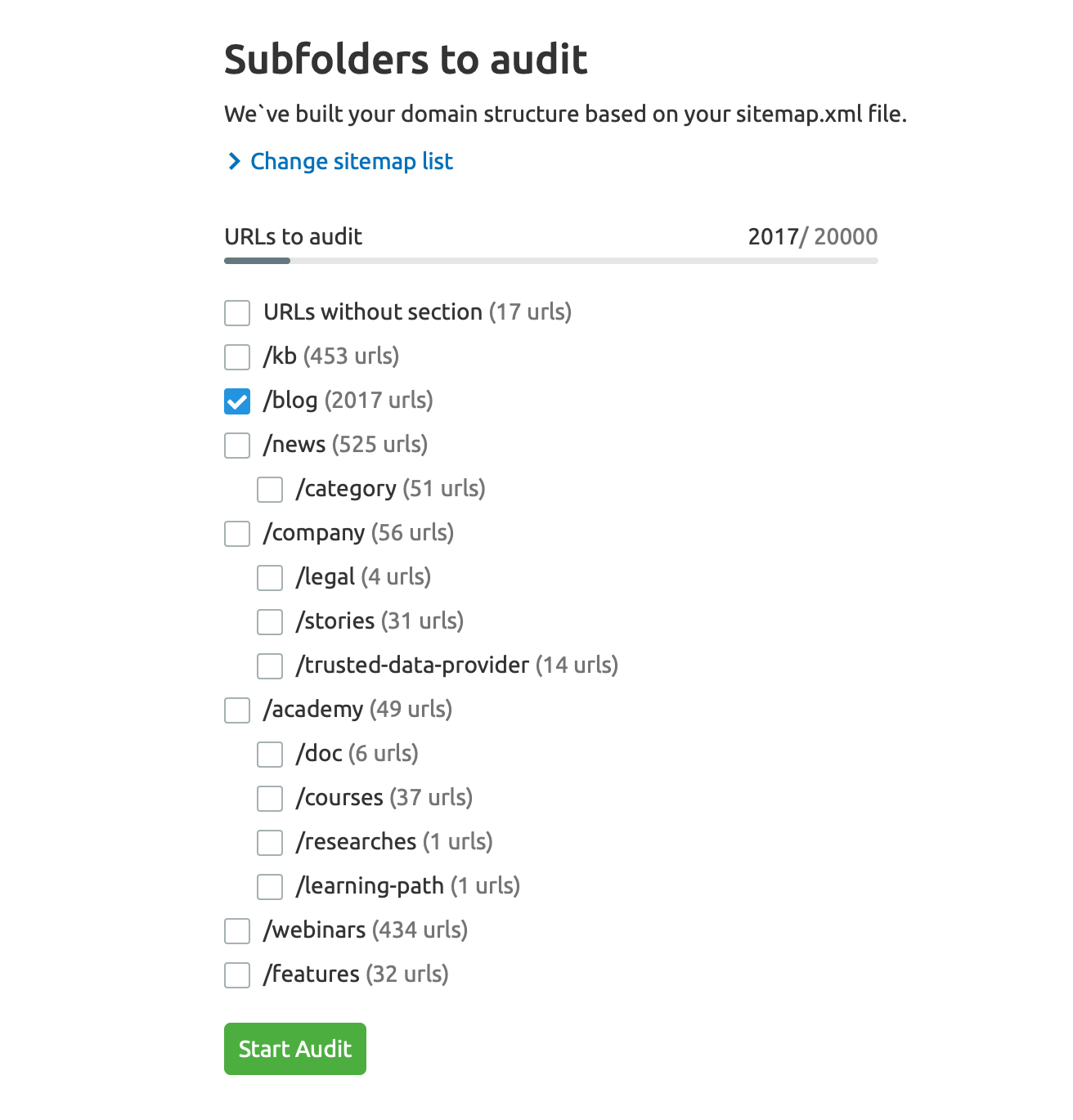
If you don’t have a sitemap, use a sitemap generator tool to create one for your website. Having a sitemap is not only useful for a content audit, but it also makes it easier for search engines to understand your website structure and find all pages you feel are important.
Check out this blog post to discover the top sitemap generators and free WordPress plugins for sitemaps. When you’re done, make sure you submit your sitemap to Google Search Console.
Catalog Your Content
After collecting your URLs, use an online tool or a spreadsheet to sort them by different criteria, and track it with your team members.
You can catalog your content by the following categories:
Buyer’s journey stage (awareness, consideration, decision);
Content type (blog post, manual, product description, landing page);
Content format (text only, images/video present, with/without call-to-action);
Number of words;
Date of publication or last modification;
Content hub (or cluster);
Author (if you have multiple writers on your website).
It is also very useful to collect metadata (title, meta description, h1) for each piece of content so you can check and update all metadata in the same place.
Finally, create columns with your metrics to collect data for each web page. Your content audit spreadsheet may look like this:
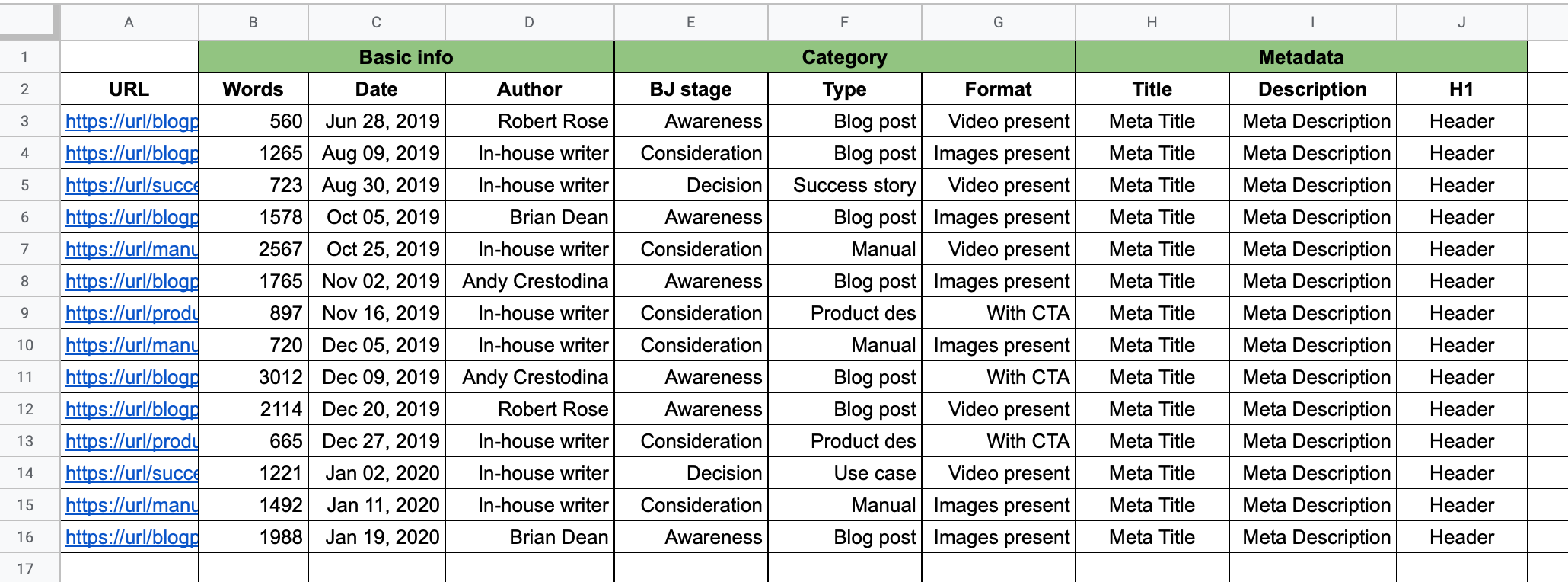
Step 3: Collect and Analyze Data
Data collection is a complex and lengthy process. Usually, you have to recover data from multiple sources and add it manually to your spreadsheet. If you want to save time, use a content audit tool that automatically collects data according to your goals and metrics.
The Semrush Content Audit tool audits your website content and provides you with various data, such as social shares from Twitter and Facebook, backlinks, metadata, content authors, and content length for each URL.
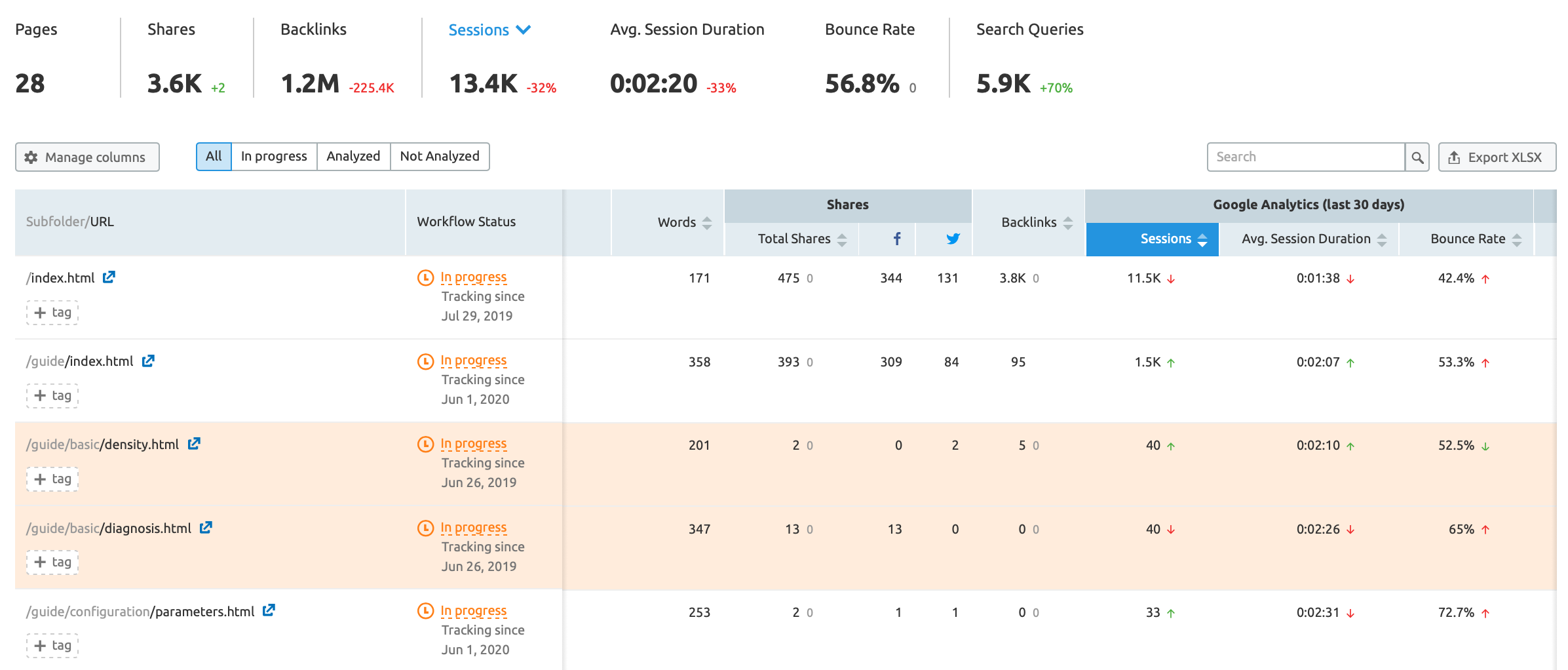
Connect your Google Analytics and Google Search Console accounts to add depth and breadth to your data. You’ll be able to see additional metrics for each URL, including sessions, average session duration, pageviews, average time on page, bounce rate, and search queries.
You can switch between Sessions and Pageviews data for every page in one click.

To gather the performance metrics of your guest posts or any content published on third-party websites, you can use the Post Tracking tool. The tool tracks articles’ keyword rankings, shares, backlinks, and referral traffic on a daily basis.
If you want to capture a wider range of data, here are some analytics tools that can prove useful for a content audit:
Google Analytics helps you to understand which content is performing best in terms of traffic, engagement, and conversion rates. You will also be able to estimate how effective your content has been in achieving your marketing and business goals.
Semrush Position Tracking allows you to track your rankings for target keywords. This tool can help you find content with good SEO potential (for example, web pages that ranked in the top 5 before, or pages ranking close to the top positions). By updating these pages, you can quickly reach better positions in search engines.
ContentWRX Audit. Using this tool, you can get information about your file types, metadata and page-level details that include images, documents, video, and screenshots of every page. You will also be able to sort your results, and export data for offline analysis.
Content Square helps you to analyze user behavior to understand what is and isn’t working on your web page, and conduct a customer journey analysis accordingly. You can assess your page elements in terms of impact, performance, and usability to identify areas for subsequent updates.
Semrush Site Audit comes in handy if one of your main audit goals is to improve your rankings, as it allows you to identify technical issues on your website.
After collecting metrics, your spreadsheet may look like this:

How to Interpret Your Content Audit Data
You need to examine your content metrics as a whole to gain a clear picture of the state of your site’s content.
For example, your web page can attract a lot of traffic, but have a high bounce rate and low session duration. This means that users are interested in your topic, but the content didn't offer them what they wanted. In this case, you have to assess different elements of your content to understand why users are leaving your web page. The problem can be rooted in your content’s relevance to titles, CTAs, or the page load time.
You should also take into account the different stages of the buyer’s journey. Your ‘Awareness’ content may attract more traffic, but have a lower conversion rate. Your ‘Consideration’ content may have less traffic, but generate more leads, and so on.
Assess Your Content Assets
Using your collected data and your metrics, try to assess each piece of content according to your goals, and assign one of the following statuses:
Keep
If your content performs well and remains relevant, you probably don’t need to update it. Think about reusing this content as part of your current content marketing strategy.
Examples: Evergreen content, success stories, FAQs, general information on your business.
Update
The content audit might help you find the web pages that are not performing well. Try to review this content and figure out how you can make it more effective. You may also find some content with outdated information that needs to be revised.
Examples: Blog posts with statistics, important articles with outdated information, low-traffic or low-conversion content.
Delete
If you are unable to improve a piece of content, or an update would take too much resource, removing it from your website may be an acceptable option. You may also have some old seasonal marketing campaigns that are no longer needed.
Examples: Content related to a particular event or activity, information about out-of-stock products, duplicate content, old campaigns.
Add a new ‘Status’ column to your content audit spreadsheet to keep track of your action plan:

Using the Content Audit tool, you can automatically organize your content into sets for further analysis, and take the necessary action:
Rewrite or remove old articles published more than 24 months ago that have been getting few or no recent views;
Update old pages that are getting some recent traffic to boost their rankings;
Quickly review new pages viewed more than 150 times in the last month, and think about how you can improve them; and
Spot poor content, such as short articles of fewer than 200 words that require action.
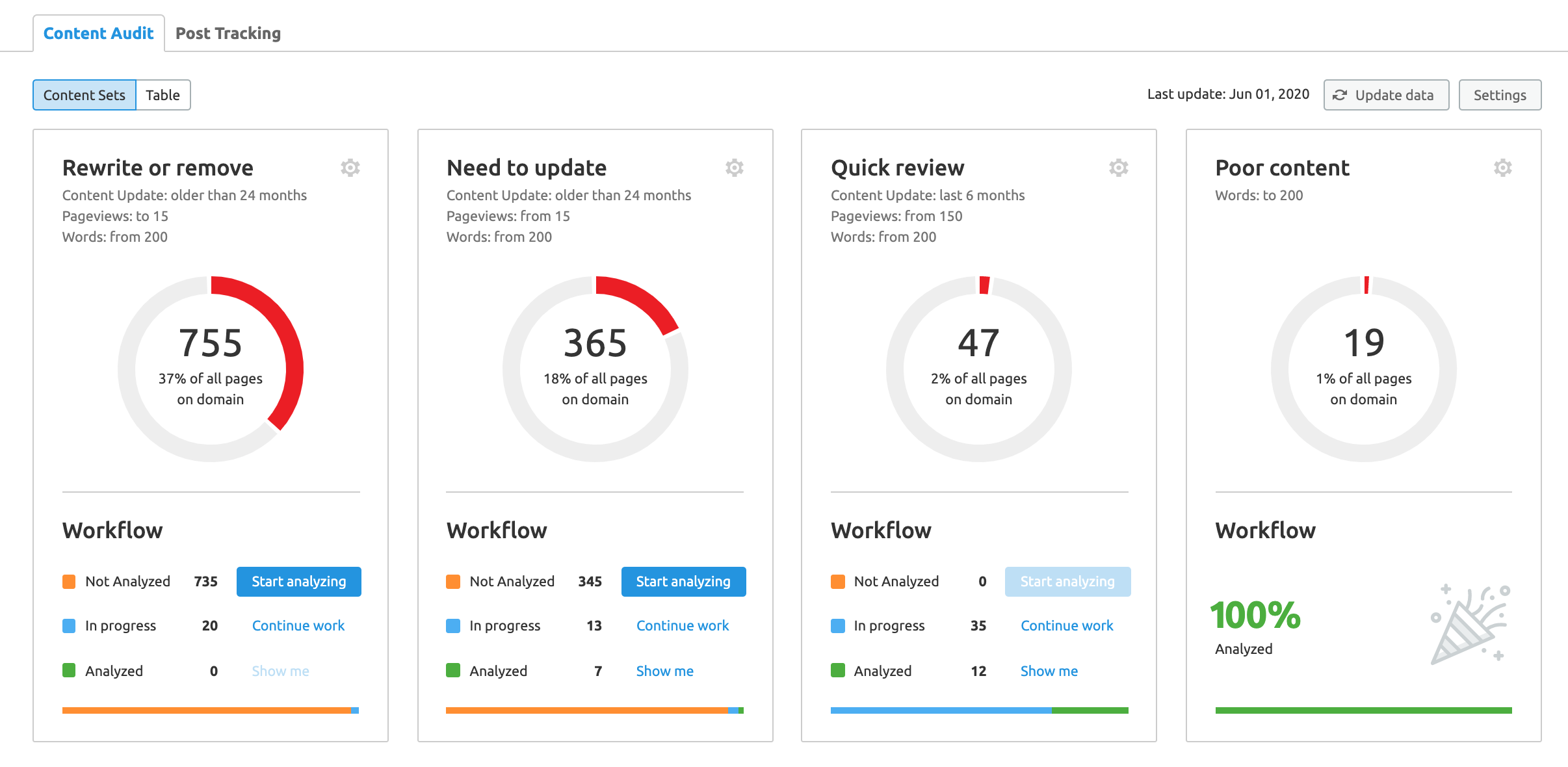
Step 4: Draw Up an Action Plan
After assessing your content, you need to set out a plan to improve it. Your action plan should be based on your goals, and the conclusions that you have drawn from your analysis.
Prioritize Your Actions
Before drawing up an action plan for each URL, refer back to the goal(s) you set out in step 1. Every investment in your content plan should align with a business goal.
Next, prioritize your actions depending on how achievable your business goals are in line with the effort required. To give an example for improving SEO results:
Actions like adding a few links to an article may require very little work, and may bring great results;
Actions like creating a big e-book may require a lot of work, but may bring poor results.
Add a priority column to your spreadsheet after you’ve weighed up the resources required against the expected results.
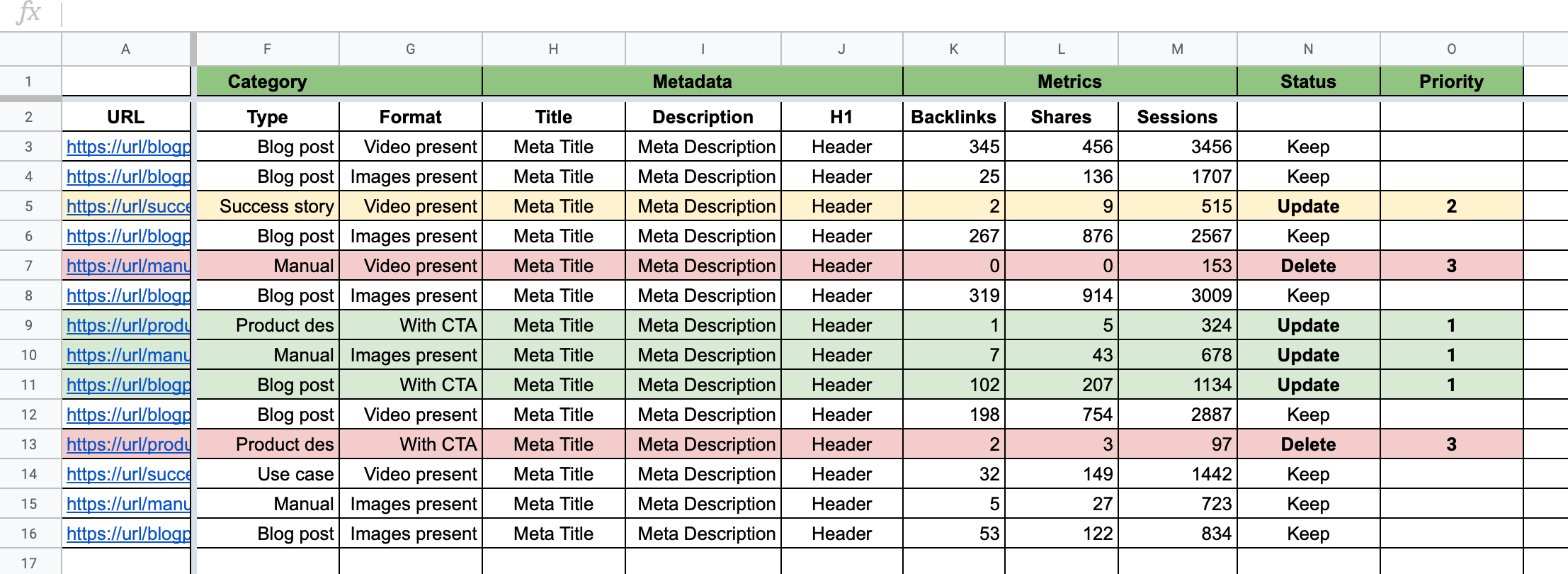
Create an Action Plan for Each URL
Once your priority list is sorted, create an action plan for each piece of content. Here are some actionable tips to include in your website content audit workflow for individual pages:
Reuse your content: Try to combine different pieces of content to create another one or publish it in a different format (e-book, infographics, slides, etc.).
Rewrite your content: If you have blog posts that are underperforming, try to rewrite them with new examples, tips, and practical details.
Expand your content: Consider adding more detail to your existing articles. According to our study, longreads of 3000+ words get 3x more traffic, 4x more shares, and 3.5x more backlinks than articles of average length.
Refresh your content: Sometimes, you don’t need to completely rewrite your article; you can simply add some relevant information (for example, new stats and trends or new product details).
Structure your content: A clear and logical structure with relevant H2 and H3 tags can help users and bots better interpret your content, and thus boost your traffic. Besides, well-structured how-to articles are more likely to rank for Featured Snippets.
Update your CTAs: You might have some outdated banners on your blog or other web pages. Replace them with relevant offers to reactivate your content marketing funnel and improve your conversion rates.
Add videos: Incorporating video increases traffic to websites, according to 87% of video marketers surveyed by Wyzowl. What’s more is that 81% also said their users spend more time on web pages containing video content.
Add images: It can make your content more engaging and attract more traffic to your website from Google Images. By integrating videos and images on a web page, you increase the chances of appearing in SERP features.
Optimize metadata: Try to rewrite your titles, meta descriptions, and h1. Use other keywords to make it more natural and attractive for users and search engines.
Optimize internal linking: Add links pointing to new articles in blog posts with related topics. This can help to improve your website organization, and decrease your bounce rate. You can also optimize your internal linking according to the buyer’s journey: Awareness content should link to Consideration articles, and Consideration articles should link to Decision content, not the other way around.
Use 301 redirects for web pages removed from your website. This allows you to avoid “not found” pages and improves user experience.
Inform Google about your content updates by using Google Search Console. The URL Inspection tool within Search Console allows you to submit recently updated web pages to Google's index.To optimize your teamwork after a content audit, you can use the ‘Workflow’ feature in Content Audit—add a task, or save current metric data for each URL.
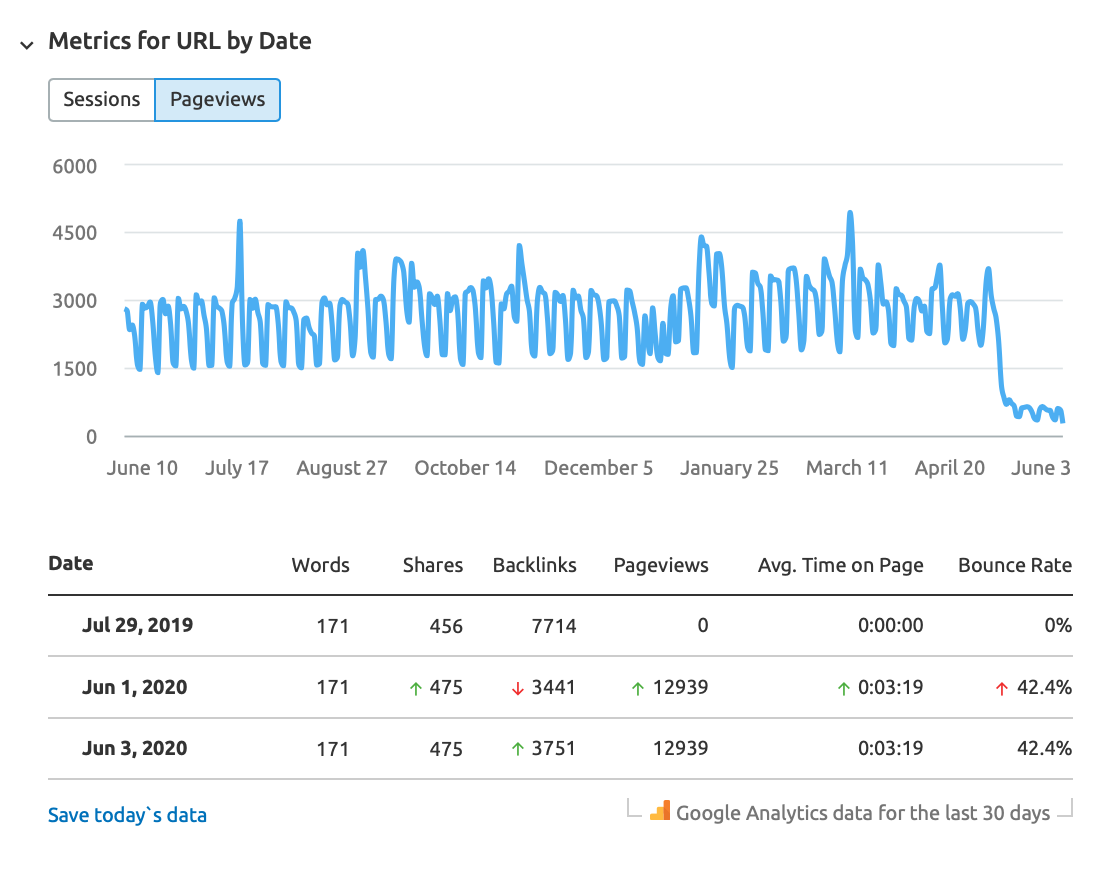
The article goes into ‘In Progress’ workflow status automatically, so that you can track how metrics change, and assess your progress directly in the tool.
Step 5: Adjust Your Content Marketing Strategy
When performing a website content audit, it is important to keep your long-term marketing strategy in mind. If you track your successes and failures, you can steer your content strategy in different directions to appeal to your target audiences in other ways, adjust assets for better organic reach, and improve conversion rates.
Take note of what works and expand upon it. Look at your least successful content, and check your competitors’ similar successful content to see where and how you could improve yours.
Reviewing your content marketing strategy is something that is needed at least once a year to ensure your tactics and activities still fit your company’s goals. If your industry changes frequently, you’d need to set more frequent review periods, e.g. once a month, or every quarter. You have to keep up with these changes and find innovative ways to keep reaching and engaging with your audiences.
What works today may not work tomorrow, so consistent adjustments should always be on the agenda. Performing content audits at least a couple of times a year is a great way to see if your adjustments and general focus are working for your business.
A Website Content Audit Checklist
Before you go, here’s a quick summary of how to conduct a website content audit that you can use as a cheatsheet:
Set up clear business goals for your content audit, such as improving your SEO results, audience engagement, or conversion rate. Match them with relevant content metrics, e.g. organic traffic, bounce rate, shares, ROI.
Collect URLs of your content and catalog your content by buyer’s journey stages, content type, author, and other categories important to you.
Collect data of content assets’ performance with the help of analytics tools. Using set metrics, assess your content assets and assign them to statuses: Keep, update, delete.
Prioritize your actions according to the business goals you defined at the first step, and draw up an action plan for each piece of content.
Adjust your content strategy based on the audit results at least once a year.
Have you already performed a content audit? What were your approaches and best practices? What did you learn in the process? Share your experience in the comments!
Innovative SEO services
SEO is a patience game; no secret there. We`ll work with you to develop a Search strategy focused on producing increased traffic rankings in as early as 3-months.
A proven Allinclusive. SEO services for measuring, executing, and optimizing for Search Engine success. We say what we do and do what we say.
Our company as Semrush Agency Partner has designed a search engine optimization service that is both ethical and result-driven. We use the latest tools, strategies, and trends to help you move up in the search engines for the right keywords to get noticed by the right audience.
Today, you can schedule a Discovery call with us about your company needs.
Source:





